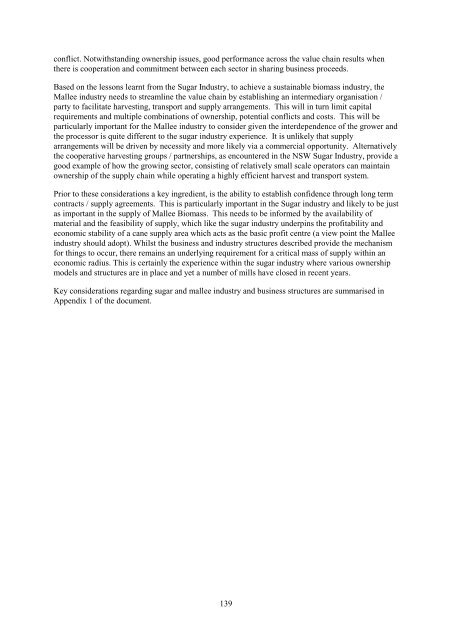Download (4Mb) - USQ ePrints - University of Southern Queensland
Download (4Mb) - USQ ePrints - University of Southern Queensland
Download (4Mb) - USQ ePrints - University of Southern Queensland
You also want an ePaper? Increase the reach of your titles
YUMPU automatically turns print PDFs into web optimized ePapers that Google loves.
conflict. Notwithstanding ownership issues, good performance across the value chain results when<br />
there is cooperation and commitment between each sector in sharing business proceeds.<br />
Based on the lessons learnt from the Sugar Industry, to achieve a sustainable biomass industry, the<br />
Mallee industry needs to streamline the value chain by establishing an intermediary organisation /<br />
party to facilitate harvesting, transport and supply arrangements. This will in turn limit capital<br />
requirements and multiple combinations <strong>of</strong> ownership, potential conflicts and costs. This will be<br />
particularly important for the Mallee industry to consider given the interdependence <strong>of</strong> the grower and<br />
the processor is quite different to the sugar industry experience. It is unlikely that supply<br />
arrangements will be driven by necessity and more likely via a commercial opportunity. Alternatively<br />
the cooperative harvesting groups / partnerships, as encountered in the NSW Sugar Industry, provide a<br />
good example <strong>of</strong> how the growing sector, consisting <strong>of</strong> relatively small scale operators can maintain<br />
ownership <strong>of</strong> the supply chain while operating a highly efficient harvest and transport system.<br />
Prior to these considerations a key ingredient, is the ability to establish confidence through long term<br />
contracts / supply agreements. This is particularly important in the Sugar industry and likely to be just<br />
as important in the supply <strong>of</strong> Mallee Biomass. This needs to be informed by the availability <strong>of</strong><br />
material and the feasibility <strong>of</strong> supply, which like the sugar industry underpins the pr<strong>of</strong>itability and<br />
economic stability <strong>of</strong> a cane supply area which acts as the basic pr<strong>of</strong>it centre (a view point the Mallee<br />
industry should adopt). Whilst the business and industry structures described provide the mechanism<br />
for things to occur, there remains an underlying requirement for a critical mass <strong>of</strong> supply within an<br />
economic radius. This is certainly the experience within the sugar industry where various ownership<br />
models and structures are in place and yet a number <strong>of</strong> mills have closed in recent years.<br />
Key considerations regarding sugar and mallee industry and business structures are summarised in<br />
Appendix 1 <strong>of</strong> the document.<br />
139
















